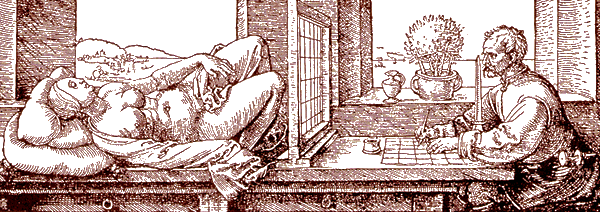The Dürer Woodcut: Postmodernism
 "Man
Drawing a Reclining Woman." From the second edition of Dürer's
Underweysung der Messung or Work about the Art of Drawing
(Nuremberg, 1538). Reprinted in and courtesy of The Complete Woodcuts
of Albrecht Dürer, ed. Willi Kurth (New York: Dover, 1963).
"Man
Drawing a Reclining Woman." From the second edition of Dürer's
Underweysung der Messung or Work about the Art of Drawing
(Nuremberg, 1538). Reprinted in and courtesy of The Complete Woodcuts
of Albrecht Dürer, ed. Willi Kurth (New York: Dover, 1963).
By the same token, as Bryan Wolf goes on to argue in that article, Dürer clearly appears here to identify with the right-hand frame and the represented artist's claim to scientific, empirical objectivity in pictorial representation. In this, Dürer contributes to the Renaissance movement away from the symbolist, religious painting of the medieval period to the mimetic realism of the next few centuries of art history, a mimetic realism that would come to its final apogée in Victorian art (before a subsequent turn to the radical and often anti-mimetic experimentation of the modern period).note As Wolf explains,
the grid is not placed, as we might expect, equidistant between artist and model. It angles back into the picture space from left to right, like a door aslant, placing us as viewers on his side of the room. The result confirms our suspicion that vision exists in Dürer's image as the scene of sexual possession. Dürer's engraving presents us with a specular economy that sublimates touch into sight and dominance into art. And we, by implication, are present as a third party to these events....
The work of the grid, then, is to close off her space, forcing us to see her through his eyes at the same time as it helps create the illusion that we are seeing her directly. (197)
The fact that Dürer finds himself at a moment of transition (from religious symbolism to mimetic realism) may help to explain how a woodcut artist from the sixteenth century could be able to anticipate many elements of postmodernity. We should also recall that Dürer found himself at the beginning of a revolution in technology, the Gutenberg revolution (which I discuss briefly in the General Intro to Postmodernism under "Oral Culture"). Indeed, his illustrations for Sebastian Brant's Narrenschiff of Sebastian Brant (one of which is featured in the Marxism section) helped to make that volume one of the first proto-mass-market phenomena, in so far as it was quickly translated into all of the leading European languages, thus making it one of the most successful published works of its age.note The very technology of the woodcut, we should recall, evolved because of the still-very-new technology of printing. It is often the case that, when it is completely new, a technology tends to be used in highly experimental, self-conscious ways, even among mainstream or otherwise conservative users (eg. the early experimentation with the internet that has now given way to a principle of usability or the innovative film techniques of Hollywood film in the 30s and 40s). Given the importance of literacy to the culture that followed the Renaissance, Dürer's own unique relation to print technology may have provided him with a certain degree of self-consciousness even as he clearly identifies with the empirically-minded artist in the woodcut. Over the next three centuries, the tools of realism merely become invisible. The next great revolutions in representational technology—sound recording, photography, film, digitality—would each similarly inspire highly self-conscious forms of experimentation.
For another application of postmodernism, click the following link:
Proper Citation of this Page:
Felluga, Dino. "The Dürer Woodcut: Postmodernism." Introductory Guide to Critical Theory.[date of last update, which you can find on the home page]. Purdue U. [date you accessed the site]. <http://www.purdue.edu/guidetotheory/postmodernism/image/>.
